Scattering flagstone across a landscape is hardly new, yet 2025’s garden and hardscape trends show fresh enthusiasm for pathways that feel organic, boost biodiversity, and solve water-management headaches all at once. Designers are pairing rugged slabs with living groundcovers, integrating permeable bases to soak up storm-runoff, embedding subtle lighting for nighttime magic, and even tucking in heating cables where winters bite. Drawing on the latest landscape data and installation know-how, the twenty ideas below illustrate how a flagstone walkway can swap bland turf for beauty, durability, and genuine ecological value. Let the possibilities underfoot guide you toward a path that fits your climate, style, and budget.
1. Meandering Flagstone Walkway Laced with Creeping Thyme
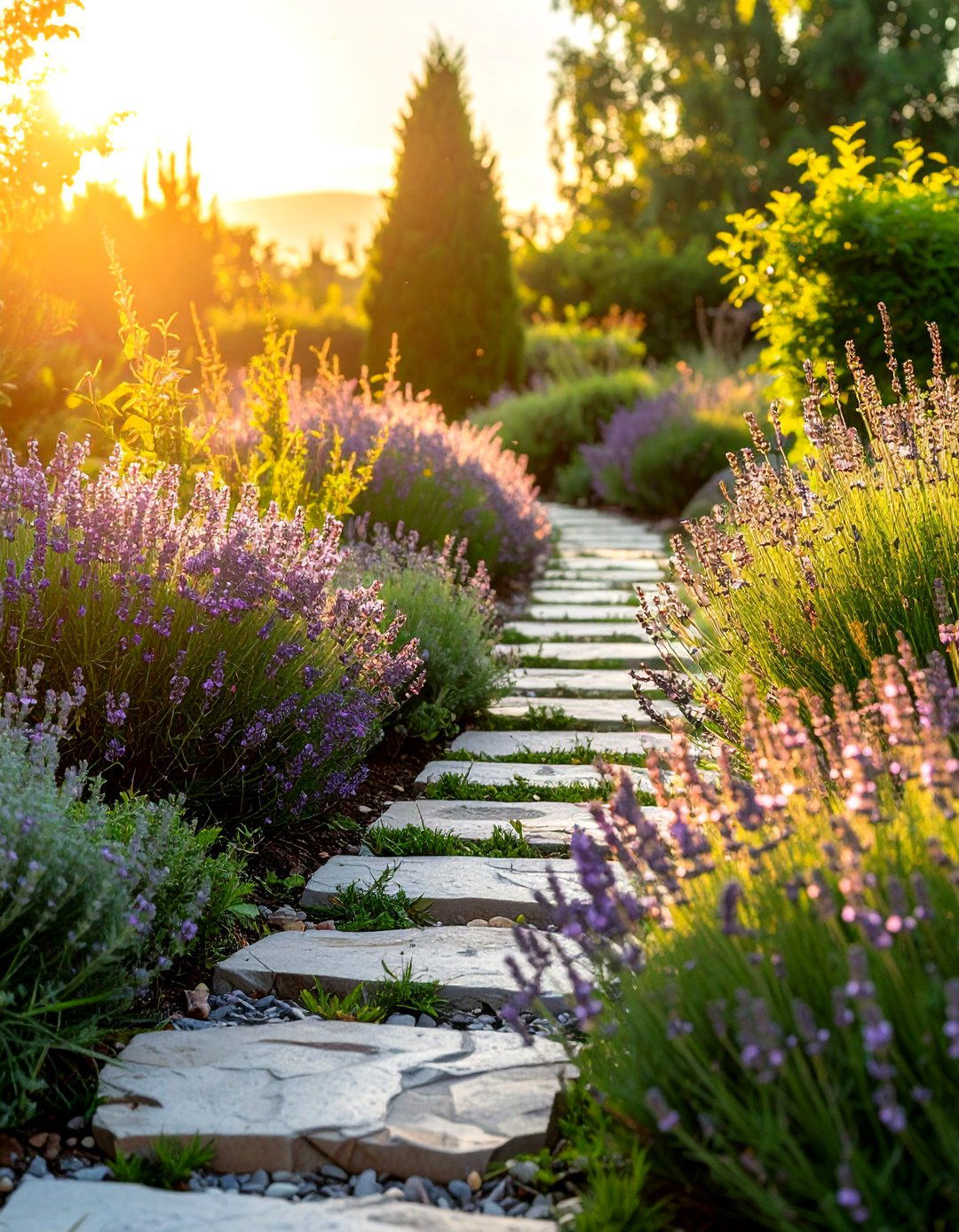
A gentle, curving line of midsize slabs set 2–3 cm apart invites visitors to slow down and breathe in aromatic creeping thyme that thrives in those gaps. Pick stones at least 4 cm thick so footsteps won’t crack them, and bed them on a 10 cm sand-and-gravel base for drainage. Low-growing thyme tolerates modest foot traffic while shading soil, suppressing weeds, and releasing fragrance each time you walk by. Trim once a year and water only during prolonged drought; the resilient herb quickly knits over new joints, softening edges and reducing runoff.
2. Flagstone-and-Grass Grid for Clean Modern Lines
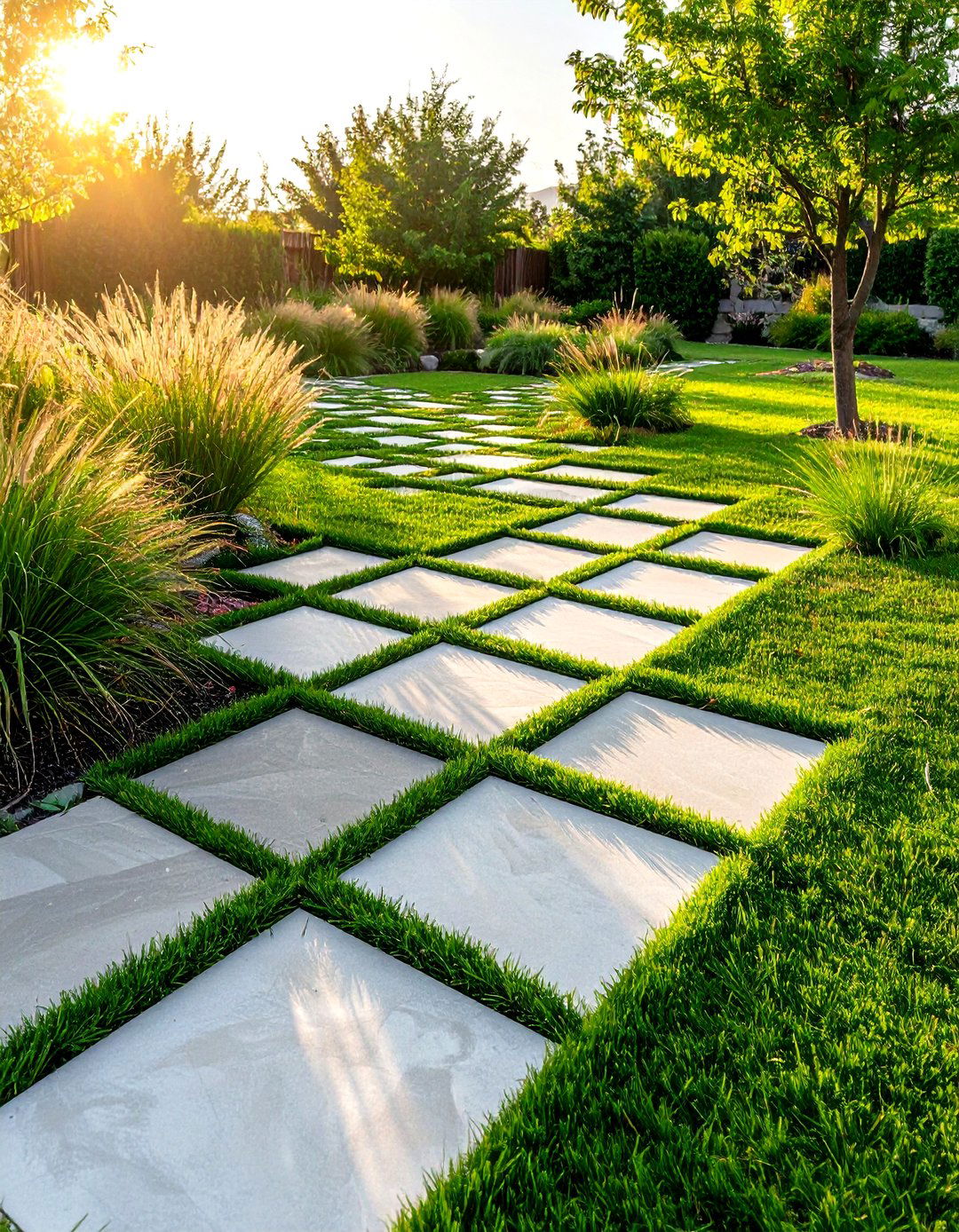
Lay square-cut flagstone in a checkerboard grid, spacing stones 5–8 cm apart and sowing drought-tough dwarf fescue or Korean grass between them. The sharp geometry highlights each slab and makes mowing easy—just adjust the mower deck high and skim across. This pattern works especially well beside contemporary architecture where right angles reign, and the vegetation breaks up heat gain compared with solid masonry. To keep joints crisp, edge the bed with steel strip and top-dress with compost each spring to feed the grass.
3. Woodland Flagstone Steppers Through Native Ferns
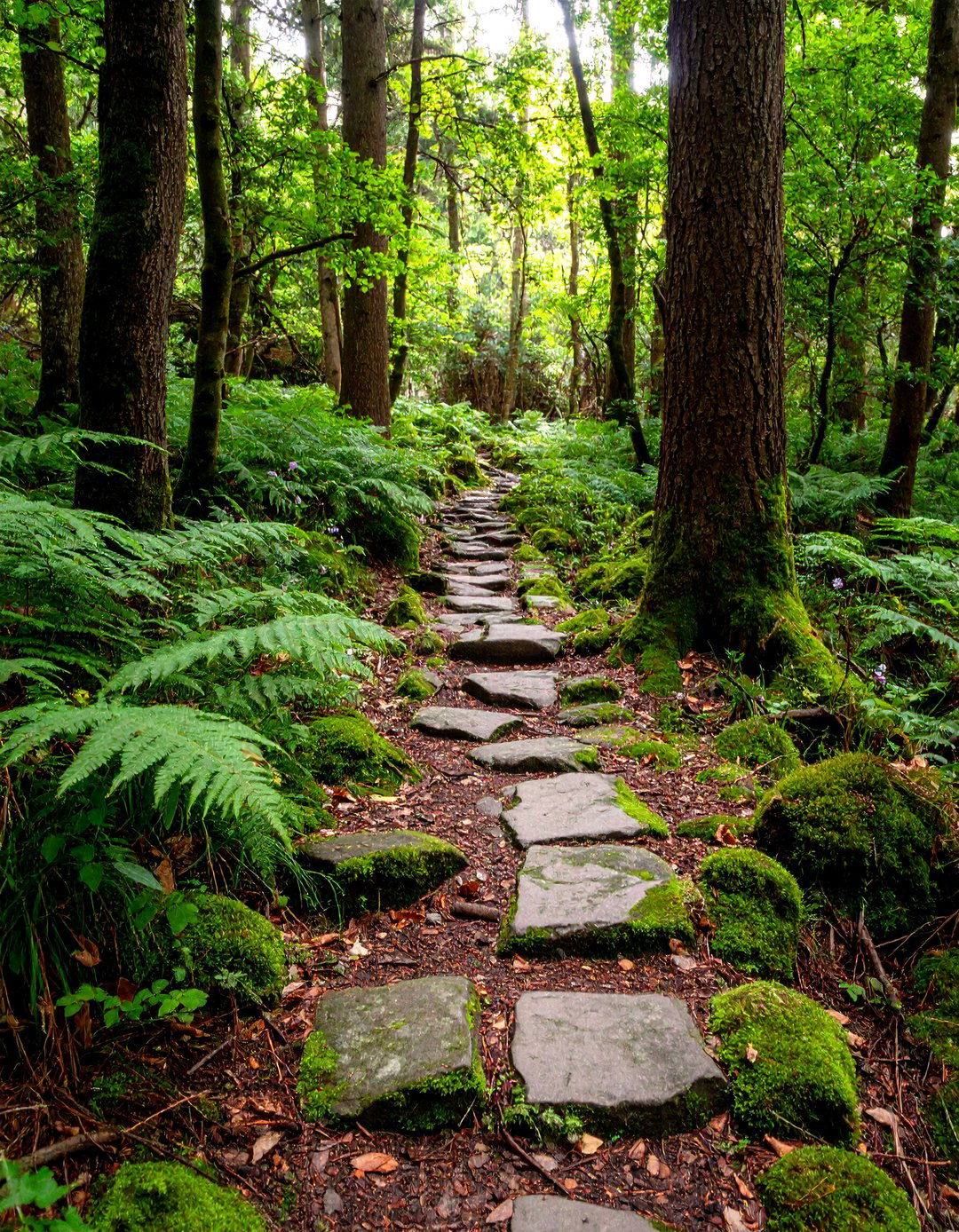
For shady lots, choose irregular slabs that mimic forest scree and tuck them among native ferns, foamflower, or mosses. Stagger stones so no single joint runs more than 1.2 m, a trick masons use to prevent visible “railroad tracks” and shifting. Dry-lay on compacted decomposed granite to let leaf litter compost in place; the microbe-rich setting nourishes surrounding understory plants. Over time, moss will colonize damp edges, turning each stone emerald when morning dew settles.
4. Linear Flagstone Walkway with Decorative Gravel Joints
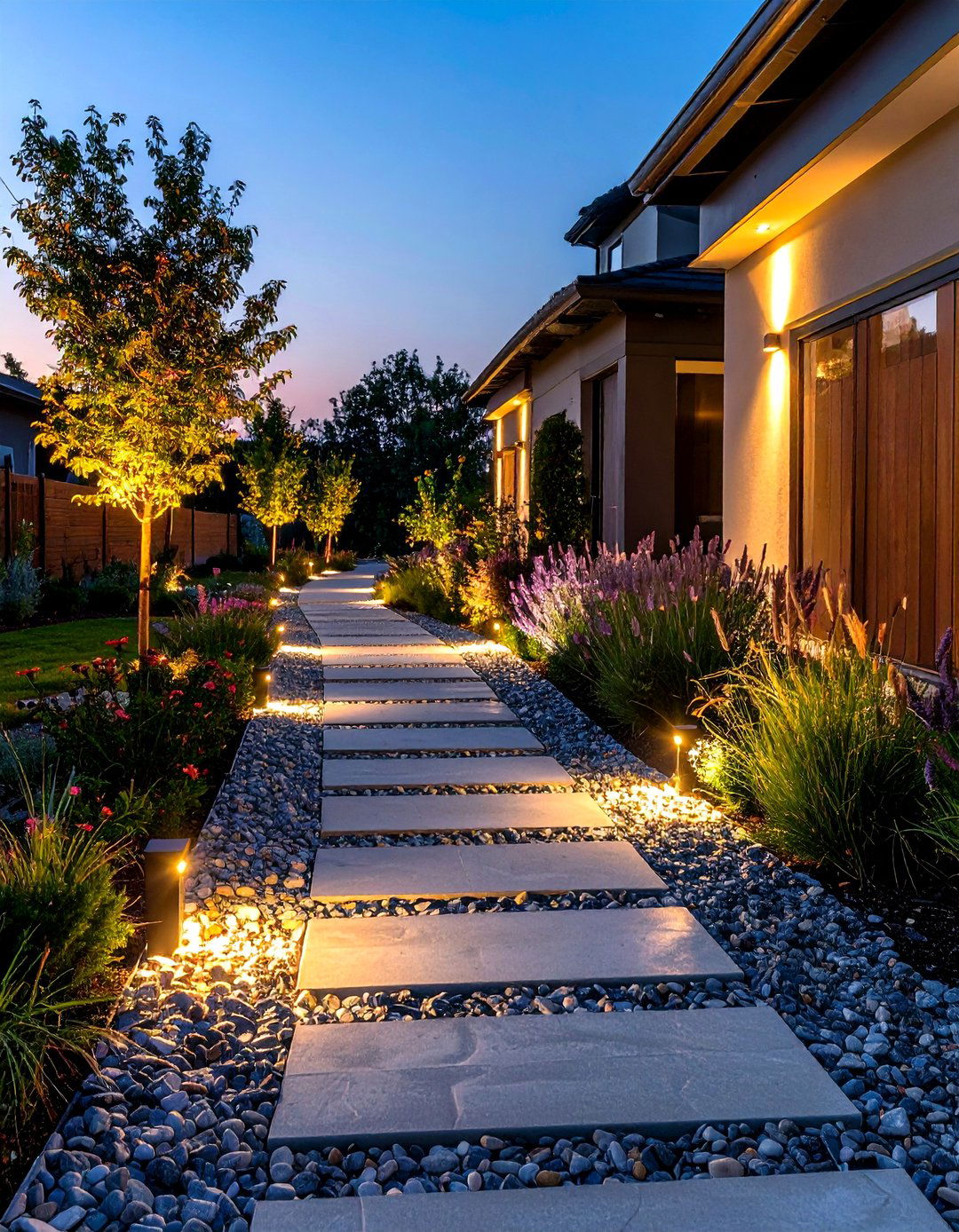
If you prefer a crisp, urban vibe, set long rectangular flagstones end-to-end and sweep angular granite chips into 1 cm joints. The tight gaps resist weed seed germination while draining quickly during downpours. Keep slabs uniform in thickness so edges stay flush with one another, then confine the run with hidden aluminum edging for a floating-slab look. Choose charcoal or buff gravel to echo the stone’s undertone and illuminate the joints with slim solar strips for after-dark drama.
5. Xeriscape Flagstone Walkway Framed by Succulents

In arid regions, surround wide stepping stones with waterwise sedum, echeveria, or low-mounding agave for a desert tapestry that needs little irrigation. A permeable gravel sub-base two hand-widths deep directs precious rainfall toward roots instead of storm drains, aligning with 2025’s drought-adaptive landscape priorities. Mulch bare spots with crushed granite to discourage weeds and reflect heat away from plant crowns. The result: a low-maintenance, color-rich path that thrives where turf would struggle.
6. Glow-Enhanced Flagstone Walkway for Nighttime Enchantment
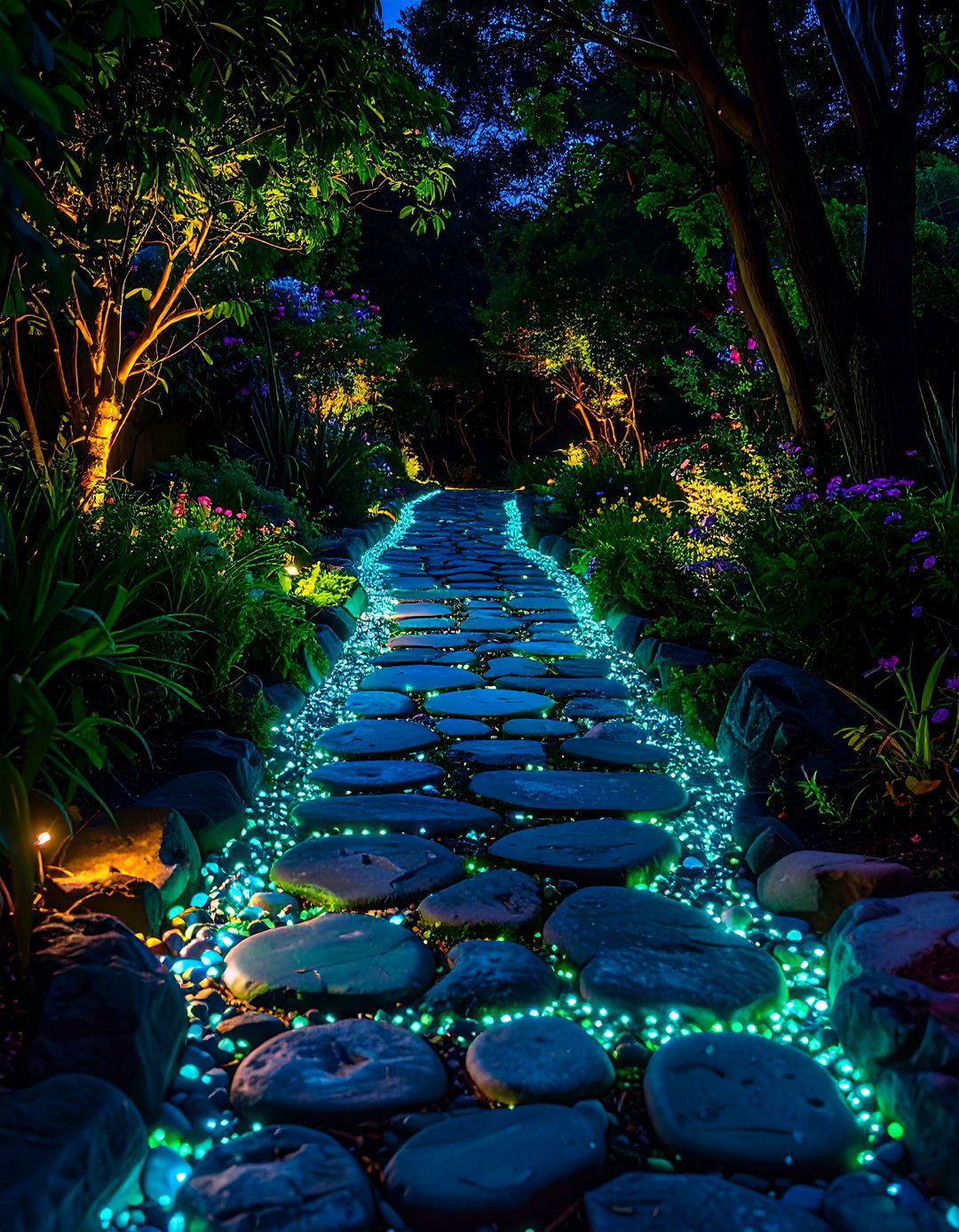
Embed photoluminescent pebbles or premixed “glow path” stones into the mortar between slabs, charging by day and emitting a soft aqua or jade halo after dusk. Position the glowing aggregate flush with the stone surface so winter sanding or sweeping won’t dislodge it. The gentle light improves way-finding without hardwired electricity and pairs beautifully with down-lit trees. Expect the afterglow to last 6–10 hours depending on the pigment blend and UV exposure during daylight.
7. Mosaic Flagstone and Permeable Paver Combo
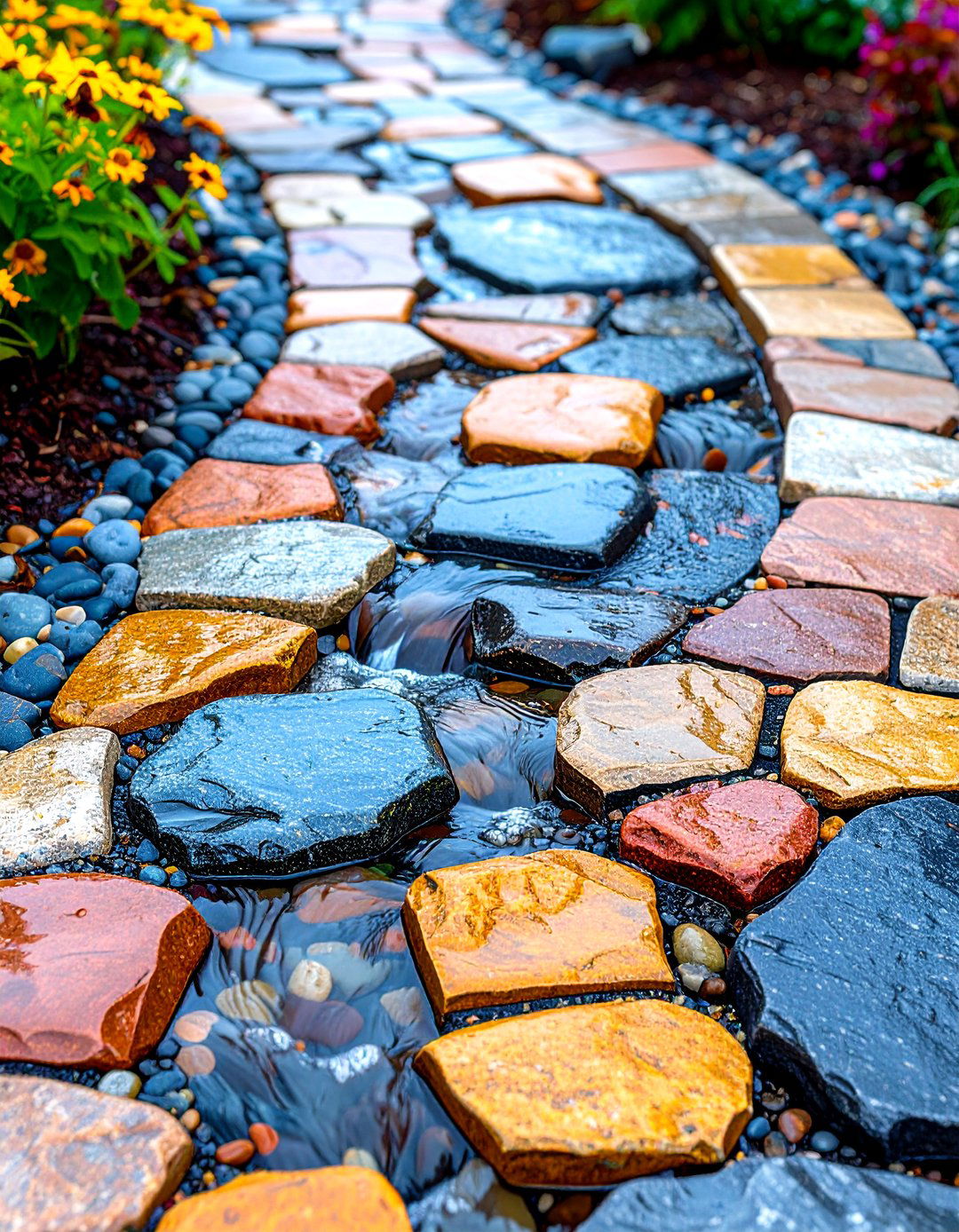
Mix irregular flagstone “islands” with small-format permeable pavers, staggering patterns so water flows through paver joints and under the larger slabs. This hybrid surface meets many municipalities’ storm-water codes yet retains a handcrafted feel. Use a geotextile fabric under the paver zones to keep sub-base gravel from migrating, and top the walkway with polymeric joint sand to lock grit while still passing water. Rake joints yearly to replace any material that washes away.
8. Symmetrical Flagstone Walkway Leading to a Formal Entry

Set evenly sized rectangles in a straight axis flanked by clipped boxwood or ornamental grass rows for classic curb appeal. Maintain consistent stone width—usually 60 cm—to suit two people walking abreast without crowding, and bevel inside corners for crisp shadow lines. Because traffic concentrates near a front door, choose at least 5 cm-thick slabs and butter each underside with a thin mortar bed for rock-solid stability.
9. Curved Waterfront Flagstone Walk Edging a Pond

Along a garden pond or pool, sweep broad pieces in a gentle arc mirroring the shoreline. Keep inside joints tight (≤10 mm) to discourage toe catches, and overhang the water 2 cm to hide liner edges while reflecting sky hues into the stone at sunset. Fill outer joints with moisture-loving Irish moss or Mazus reptans that tolerate the occasional splash and create a living filigree around each flag.
10. Permeable Flagstone Walkway over a Gravel Reservoir

Excavate 20 cm, lay a non-woven fabric, then backfill with open-graded angular gravel before topping with heavy flagstone. Leaving 15 mm gaps filled with the same gravel turns the entire walkway into a miniature rain-garden—stormwater percolates below, reducing runoff and replenishing aquifers. Such porous paths earn credits in many green-building programs and stay puddle-free even during monsoon downpours.
11. Flagstone Stair Walkway Up a Gentle Slope
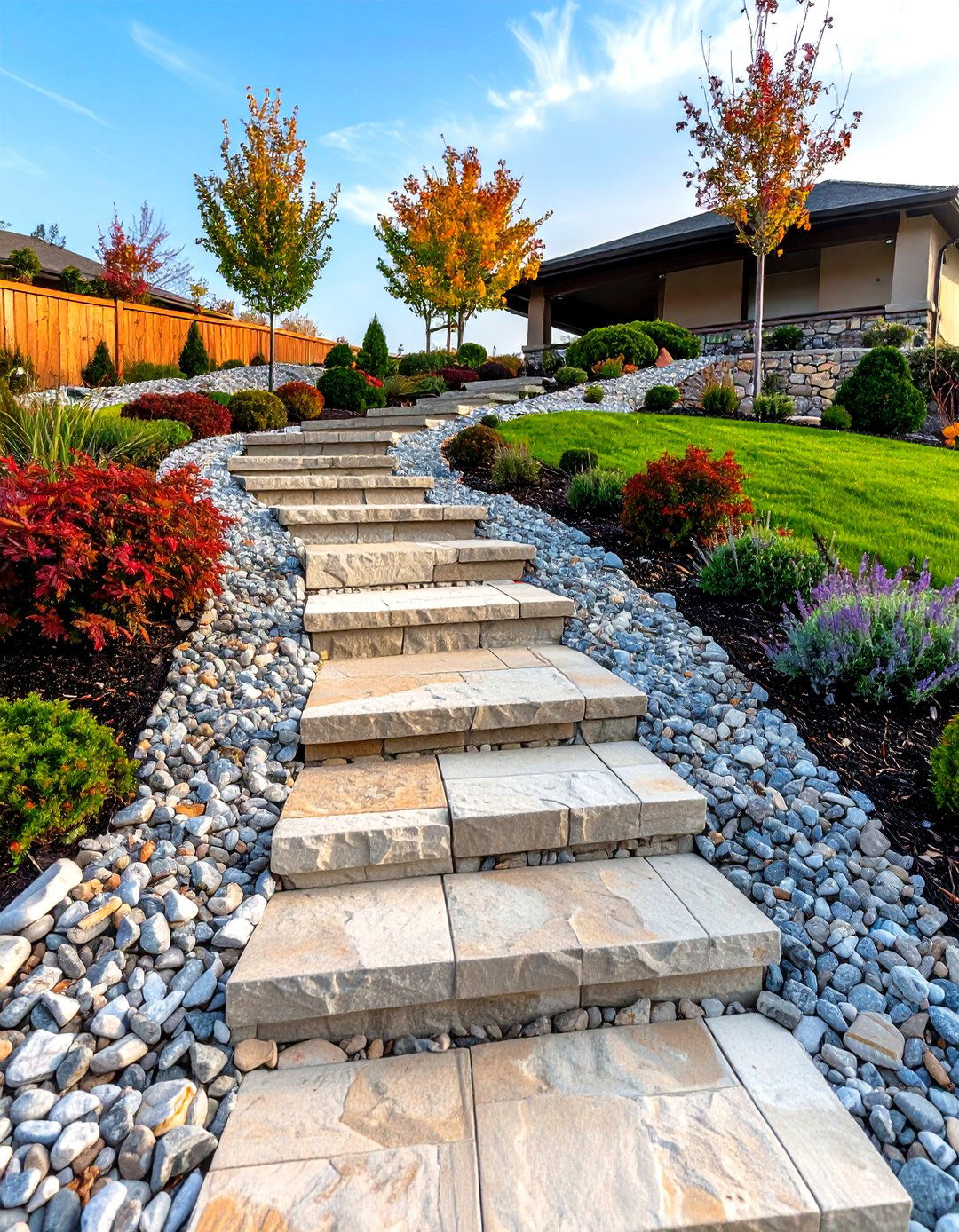
Carve shallow terraces and set stones 30 cm deep with 10 cm risers, backfilling each tread with compacted crushed rock. Where slope steepens, integrate two-stone landings every four steps for rest spots and to break momentum of stormwater. Anchor outer edges with landscape spikes through hidden steel edging to keep heavy foot traffic from drifting stones downhill over time.
12. Courtyard “Carpet” Flagstone Walkway in Tight Spaces
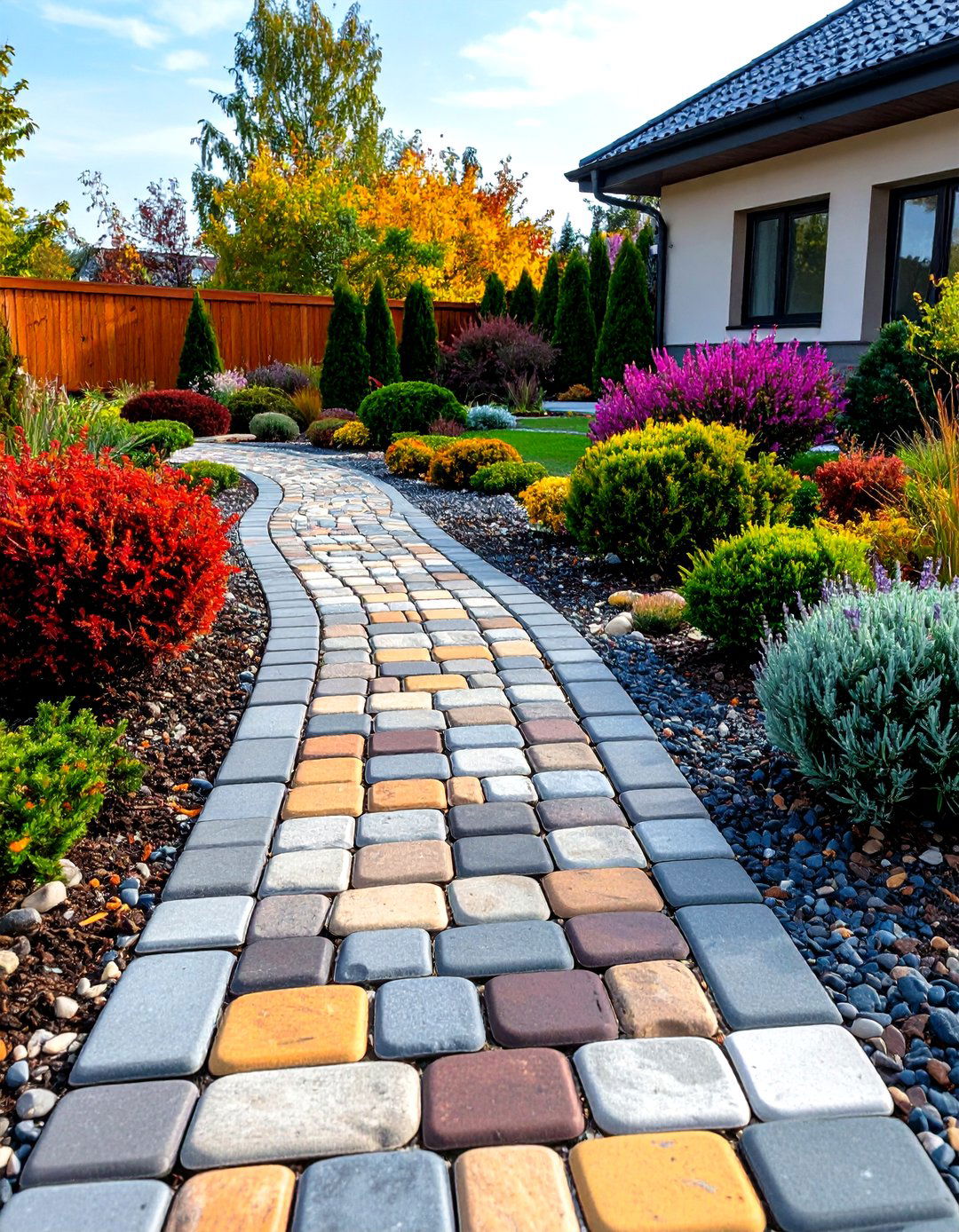
In modest courtyards, arrange small, multicolored flagstones like a woven rug, staggering tones to create subtle stripes. Dry-lay on a level sand bed so rain filters through rather than sheet-flowing toward house walls. A 5 cm soldier course of matching cobbles frames the “carpet,” finishes edges cleanly, and contains sand. Because traffic is light, annual joint re-sand and a quick sweep keep the micro-plaza looking fresh.
13. Zen-Inspired Flagstone Stepping-Stone Walkway

Place oversized, flat stones in an offset cadence across raked gravel to evoke traditional Japanese roji. Maintain even stride length—roughly 60 cm between centers—so visitors glide without breaking rhythm. Surround the path with mossy boulders and bamboo clusters for tranquil enclosure, and allow moss to creep onto the stone margins, softening boundaries between built and natural worlds.
14. Mediterranean Flagstone Walkway with Terracotta Accents
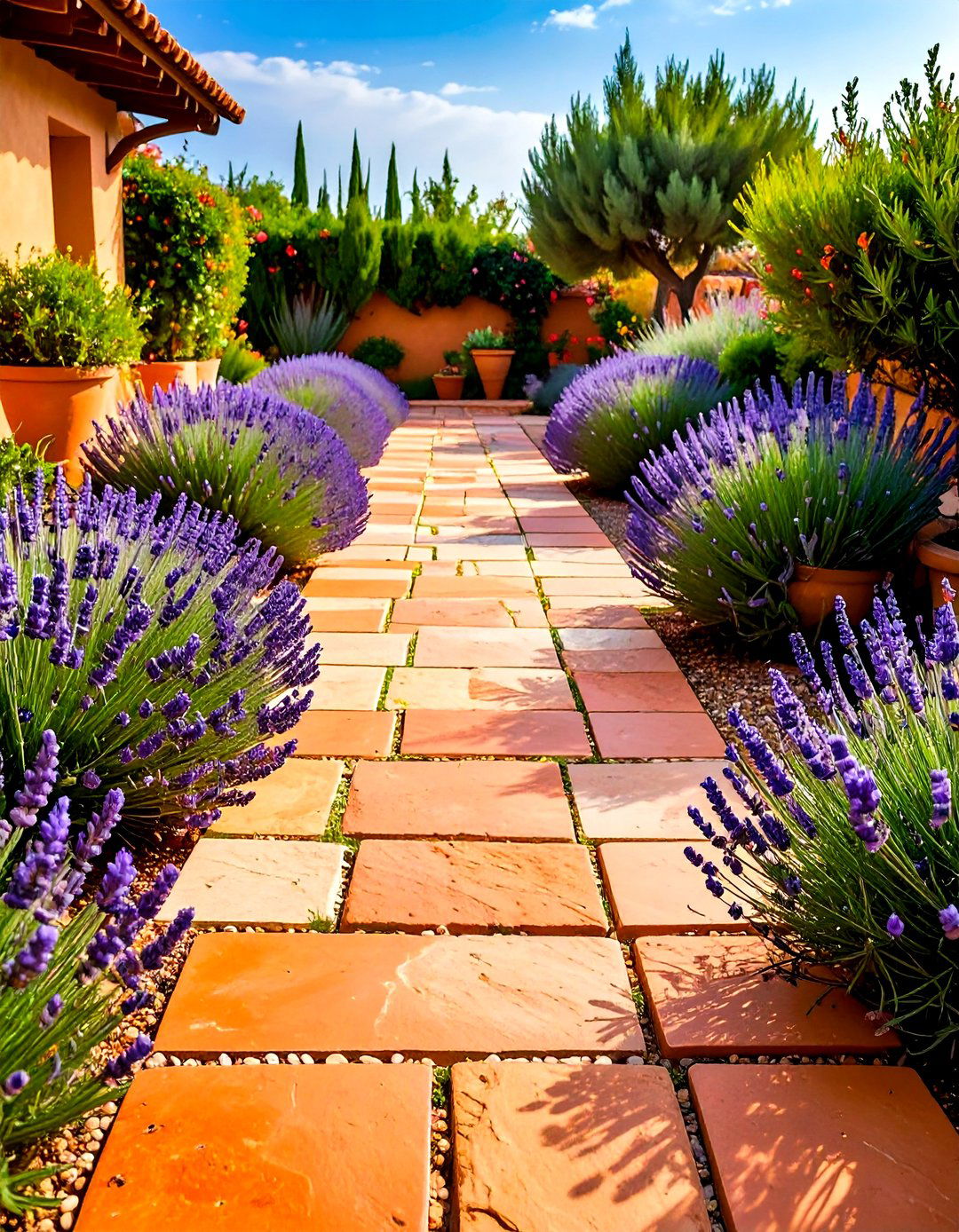
Combine warm buff or peach flagstones with inlaid terracotta tiles at random intervals for sun-washed charm. Edge the walkway with rosemary or lavender that thrives in lean, fast-draining soils and perfumes the air when brushed. A sub-base of crushed limestone reflects heat, helping aromatic herbs flourish while keeping slabs dry underfoot.
15. Pollinator-Friendly Flagstone Walkway Threaded with Ground-Cover Flowers
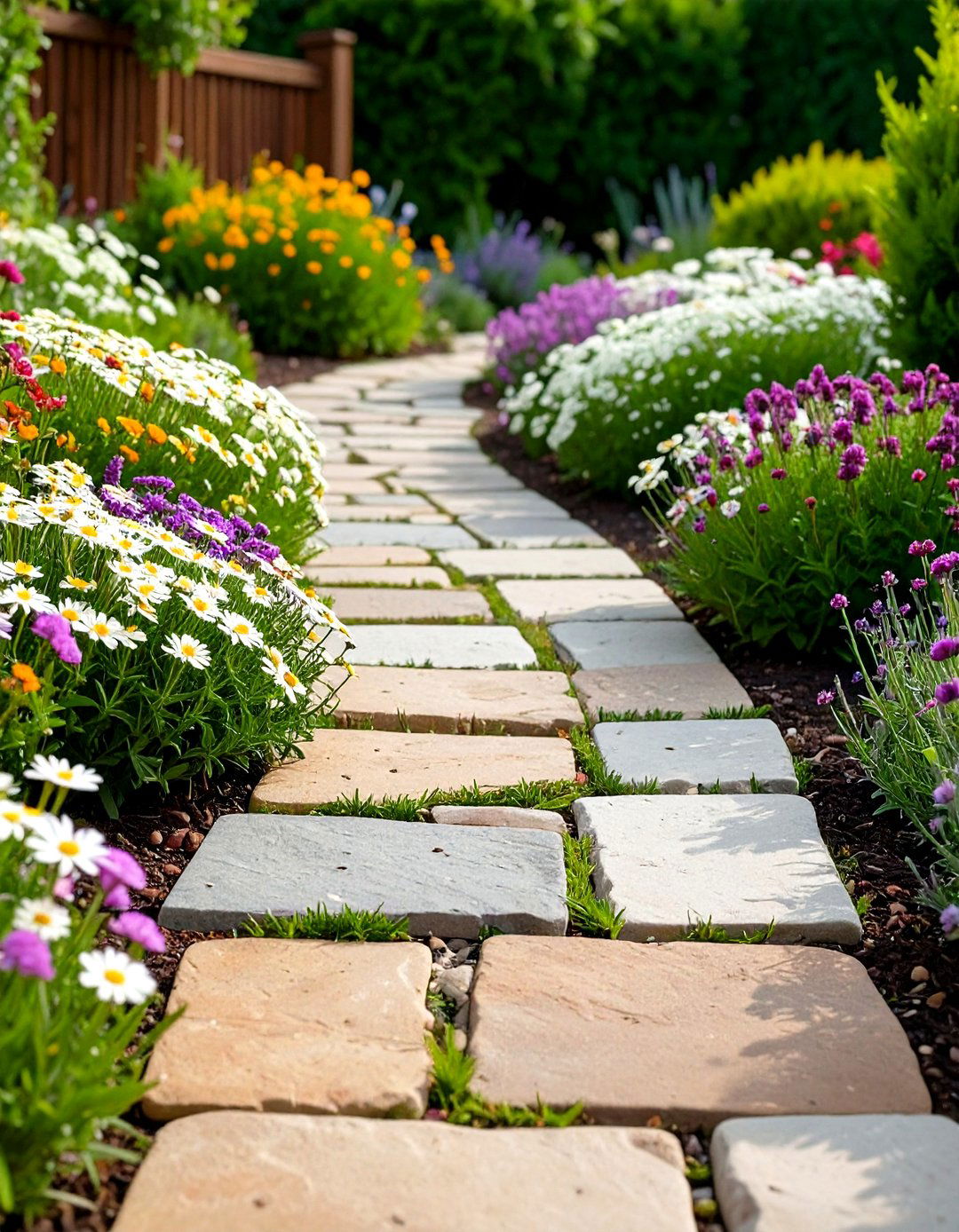
Fill wider joints—up to 8 cm—with creeping thyme, chamomile, or tiny alpine yarrow that attract bees and butterflies. Select varieties no taller than 5 cm so blooms sit below ankle height yet still lure pollinators. Water lightly during establishment, then let roots fend for themselves; the microclimate between stones stays cooler and moister than open soil, reducing irrigation needs.
16. Flagstone Walkway Illuminated with Low-Voltage Edge Lighting
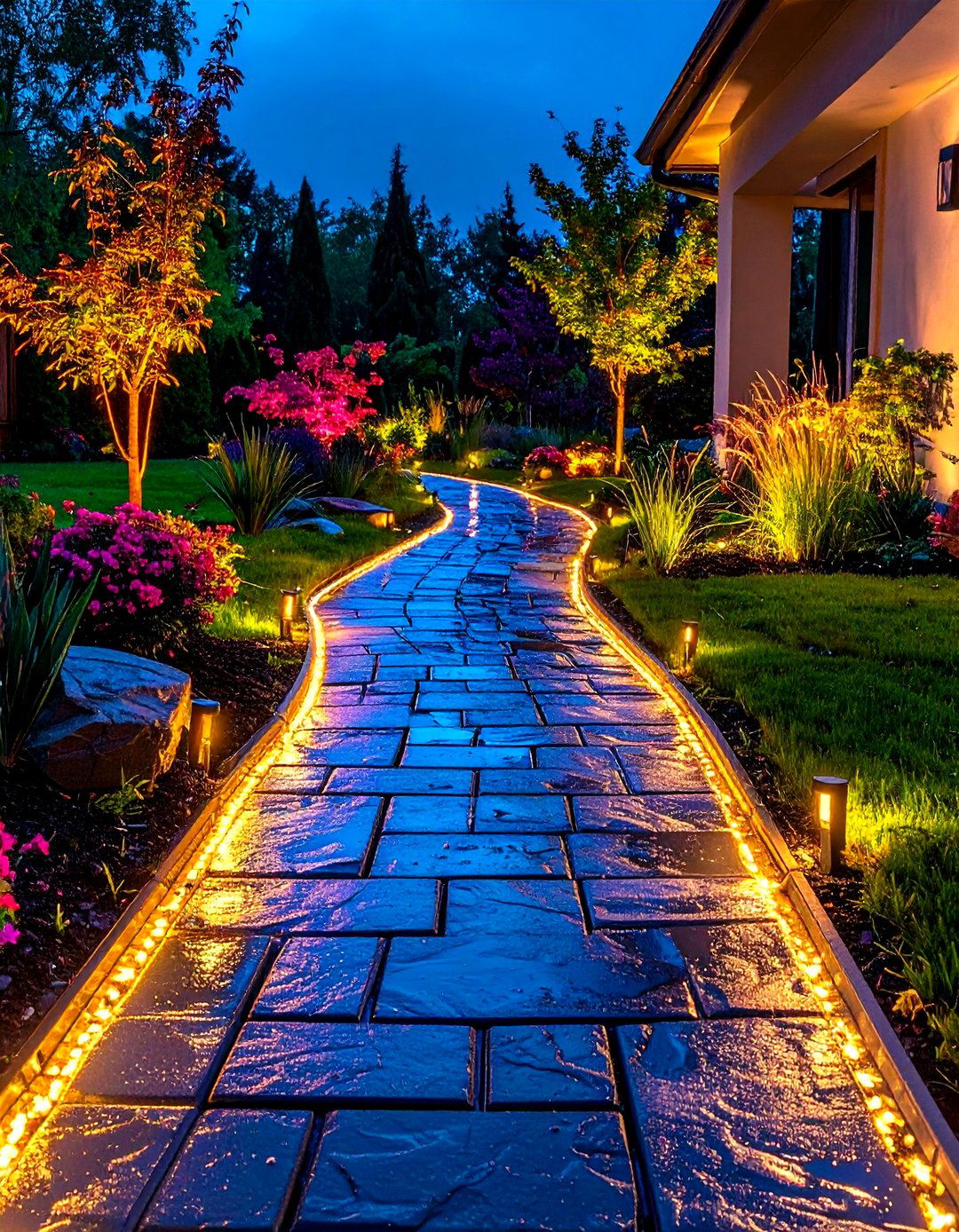
Recess LED strip fixtures or small bollards along path edges, wiring them to a dusk-to-dawn transformer for safety without glare. Where trenching could disturb tree roots, opt for standalone solar posts that charge all day. Complement lighting by brushing a thin coat of penetrating sealer on slab faces to amplify wet-look color after rain and the evening glow.
17. Artistic Flagstone Walkway Featuring Inset Fossils and Tile Shards
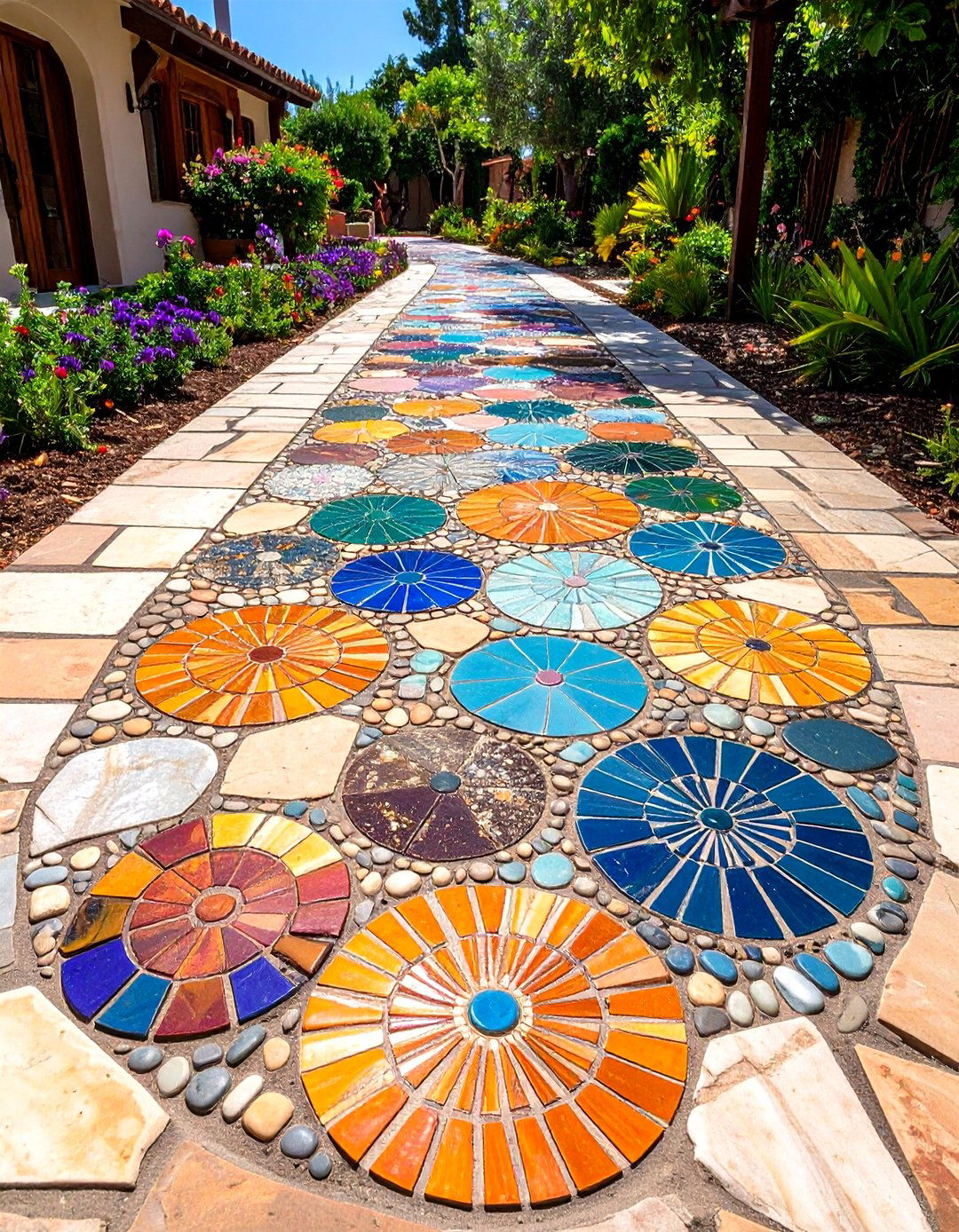
Replace an occasional flag with a slice of ammonite fossil, hand-painted Talavera tile, or a carved stone medallion to turn the path into an outdoor gallery. Ensure inserts match surrounding slab thickness so edges stay flush. For contrast, bevel the adjoining flagstone rim 5 mm and grout with a complementary pigment so insets pop visually but remain trip-free.
18. Accessible Smooth-Cut Flagstone Walkway for Wheelchair Use
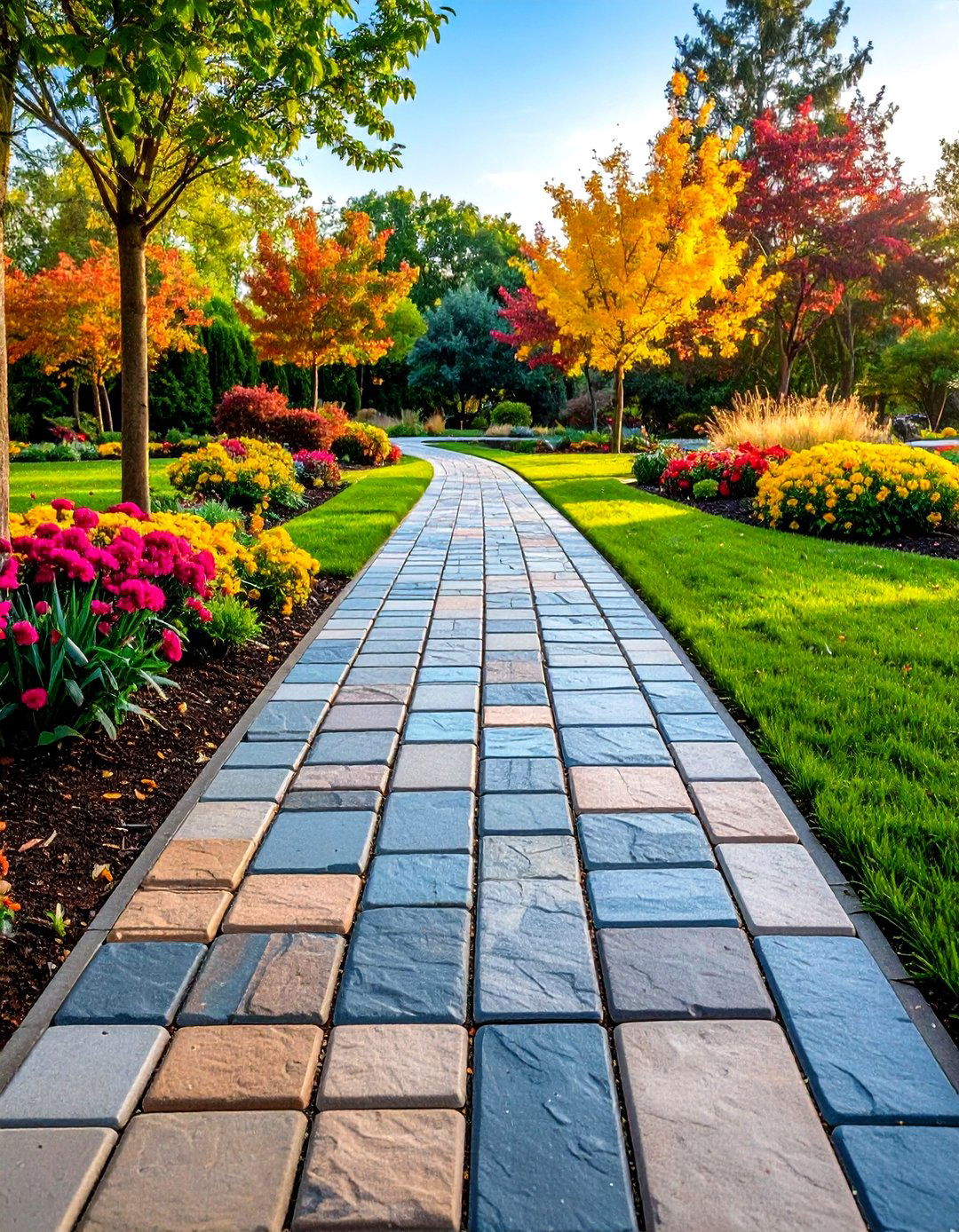
Choose sawn-top stones no more than 5 mm out of plane and maintain joints under 10 mm. Set slabs in a mortar screed and tool joints flush so wheels glide smoothly. Where grade changes, keep slope under 5 percent and provide a 1.2 m passing zone every 9 m to comply with most accessibility codes, proving stone can be both rustic and inclusive.
19. Budget-Friendly DIY Irregular Flagstone Walkway

Outline your route with a garden hose, then excavate 10 cm and tamp sub-soil firm. Lay landscape fabric, dump in 6 cm of crusher-run gravel, and top with a 2 cm sand screed before seating bargain-bin irregular stones. Fill gaps with pea gravel and mist to settle. With basic hand tools and an extra weekend, homeowners can finish 6 m² for a fraction of pro costs.
20. Snow-Melt Heated Flagstone Walkway for Cold Climates
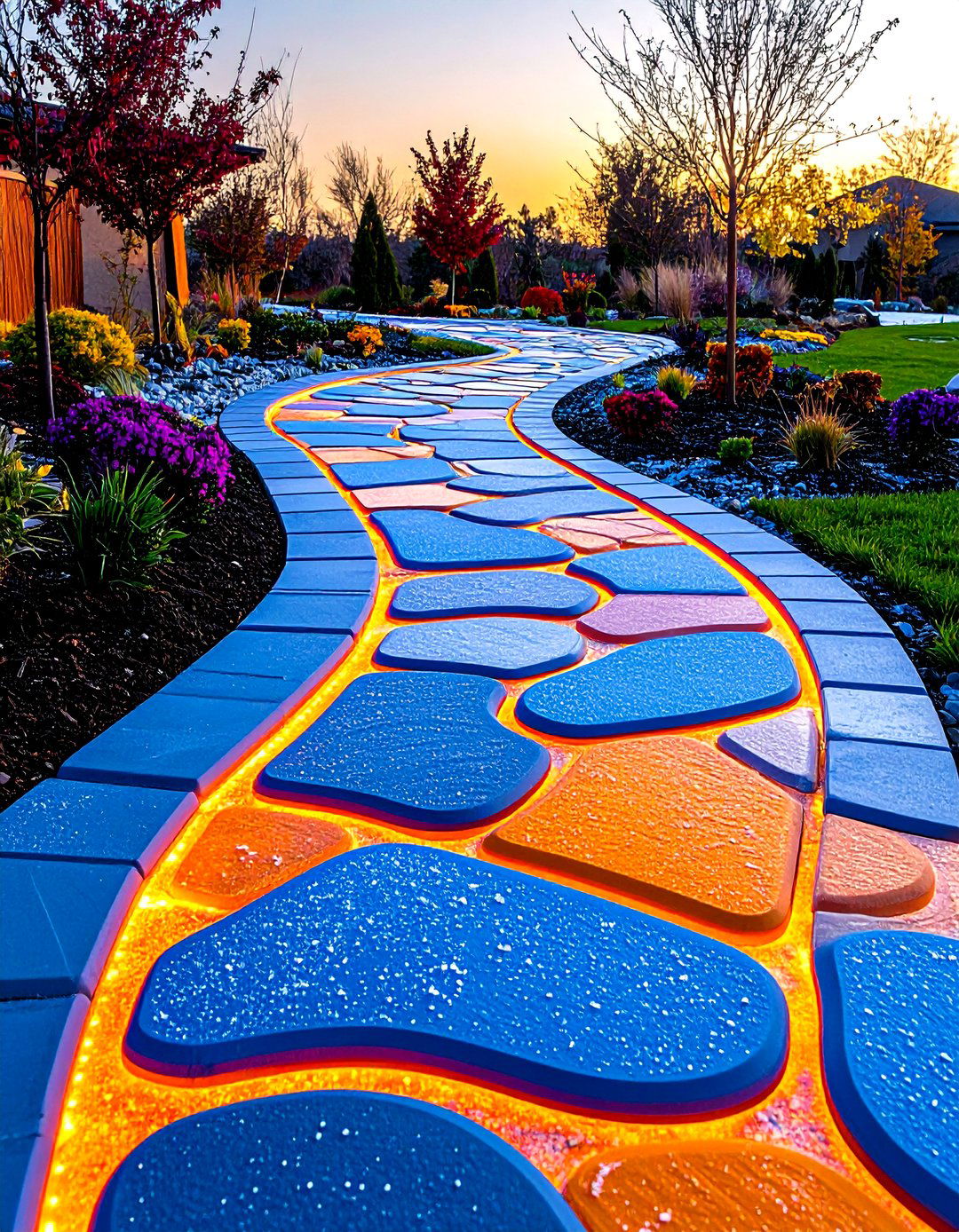
Install electric snow-melting mats or hydronic tubing beneath the stone, embedding cables in mortar on a rigid insulation board. Automated moisture-temperature sensors trigger heat only when sleet or snow hits, keeping paths ice-free while minimizing energy. Heated walks extend flagstone’s seasonal usability and eliminate harsh de-icing salts that can pit stone over time.
Conclusion:
A flagstone walkway quickly evolves from simple stepping stones into a multi-functional landscape feature when you factor in ecology, seasonality, and personal aesthetics. Whether you weave aromatic herbs between slabs, harvest storm-water beneath permeable joints, or spark nighttime magic with glow aggregates, each idea turns ordinary passages into intentional experiences that welcome every step. Use the concepts above as flexible blueprints—swap plants for your hardiness zone, adjust sub-bases for local soil, or blend patterns to match your home’s architecture. With thoughtful placement and a dash of creativity, your new flagstone walkway will guide feet, soak rain, and delight the senses for decades to come.


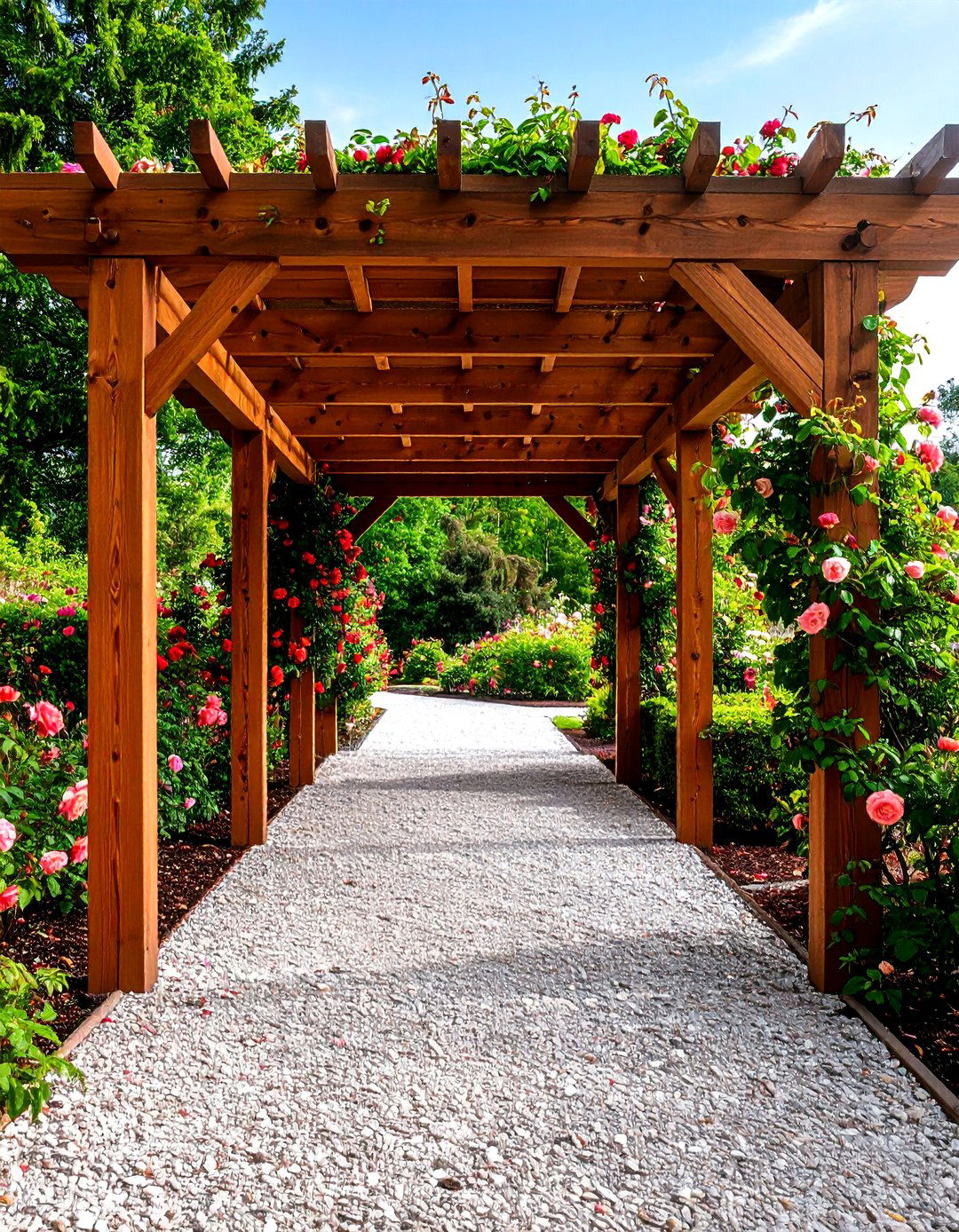
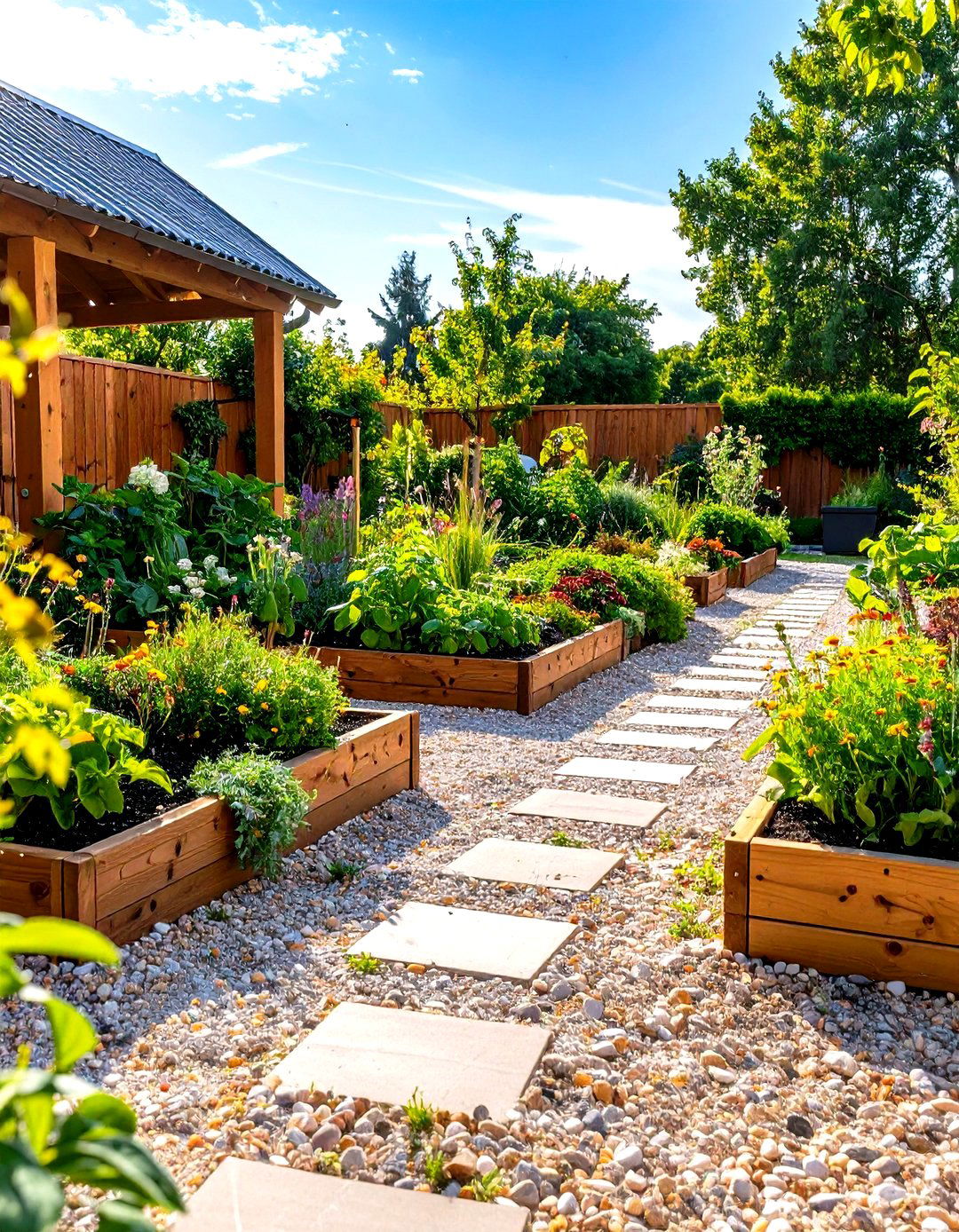
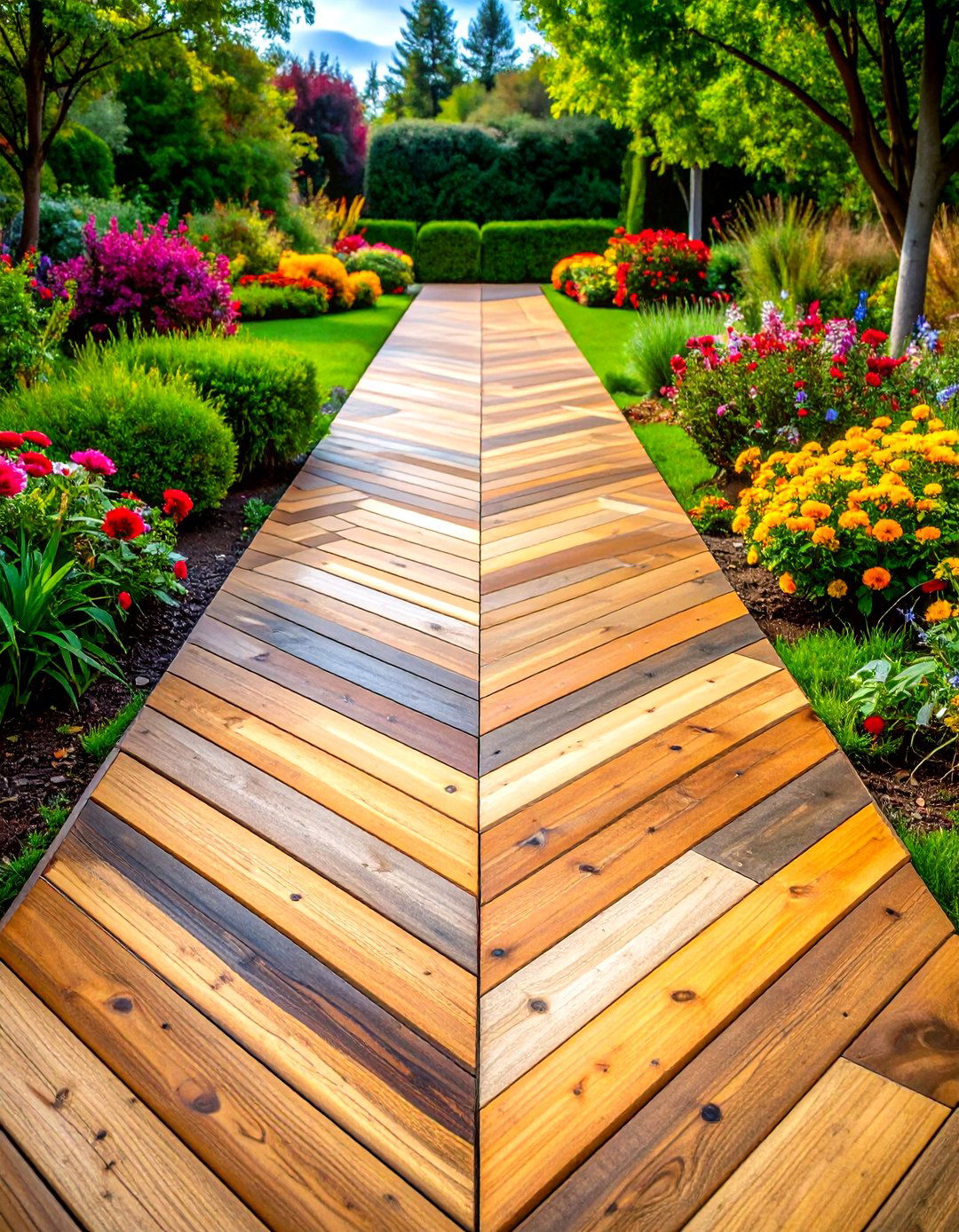
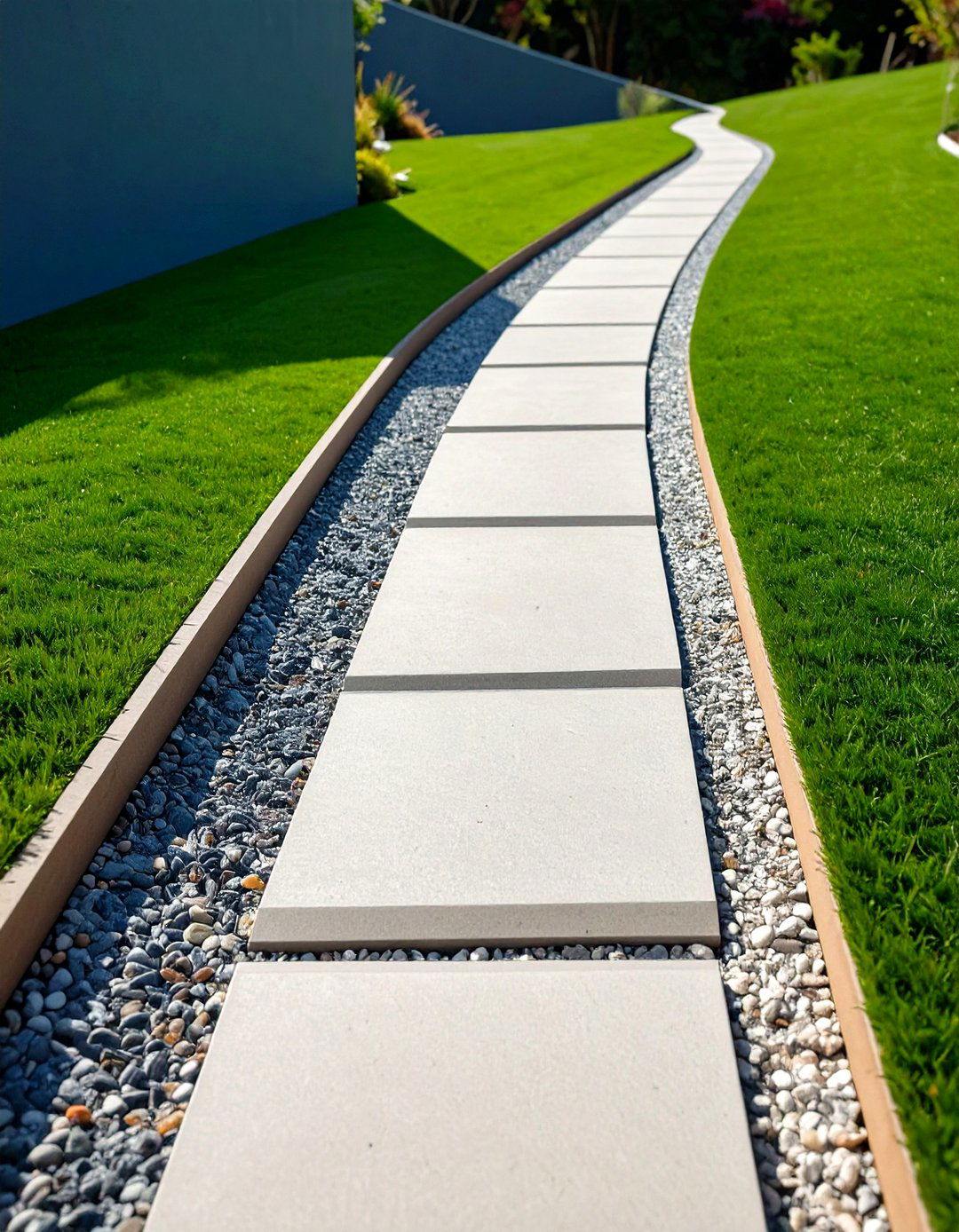
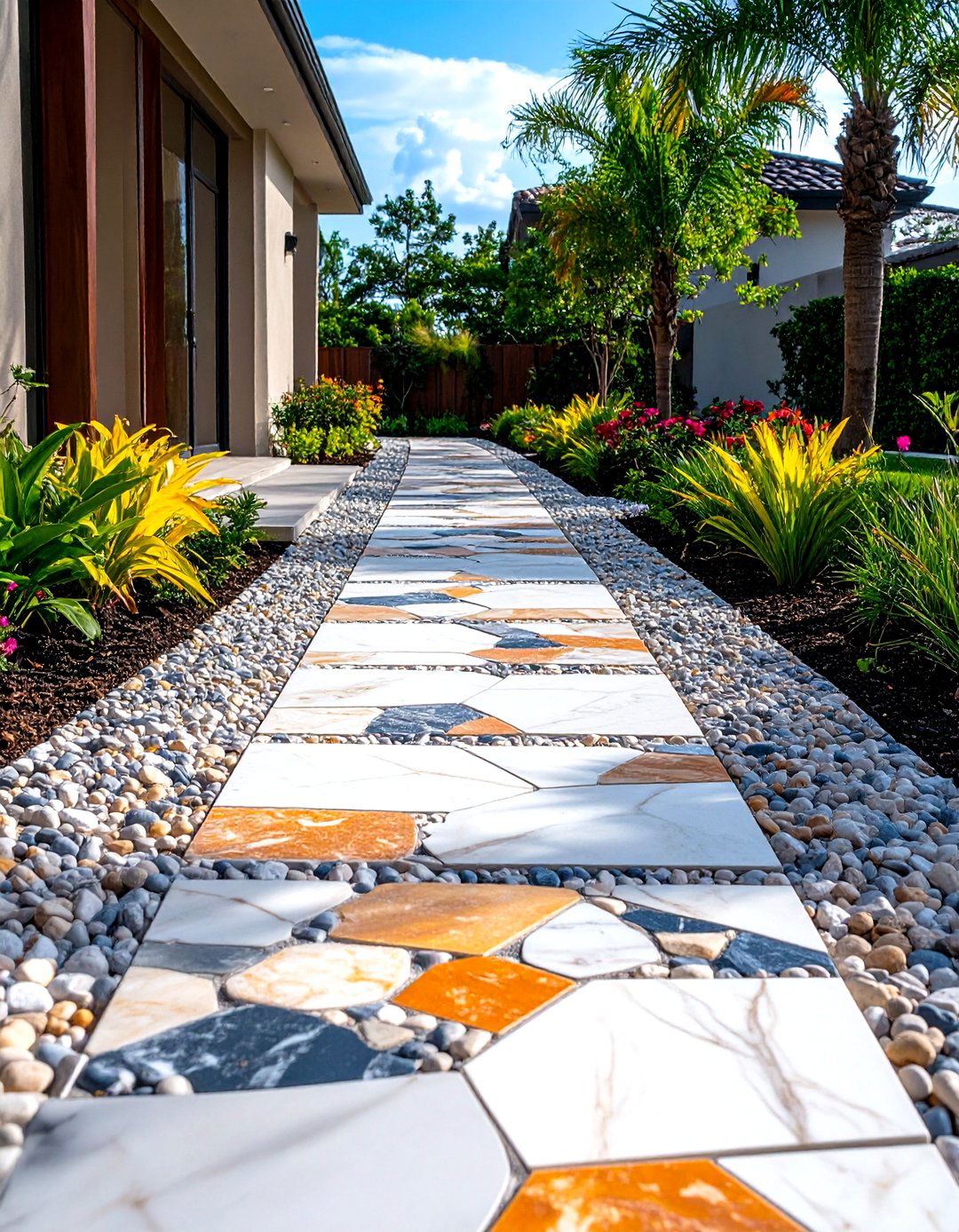
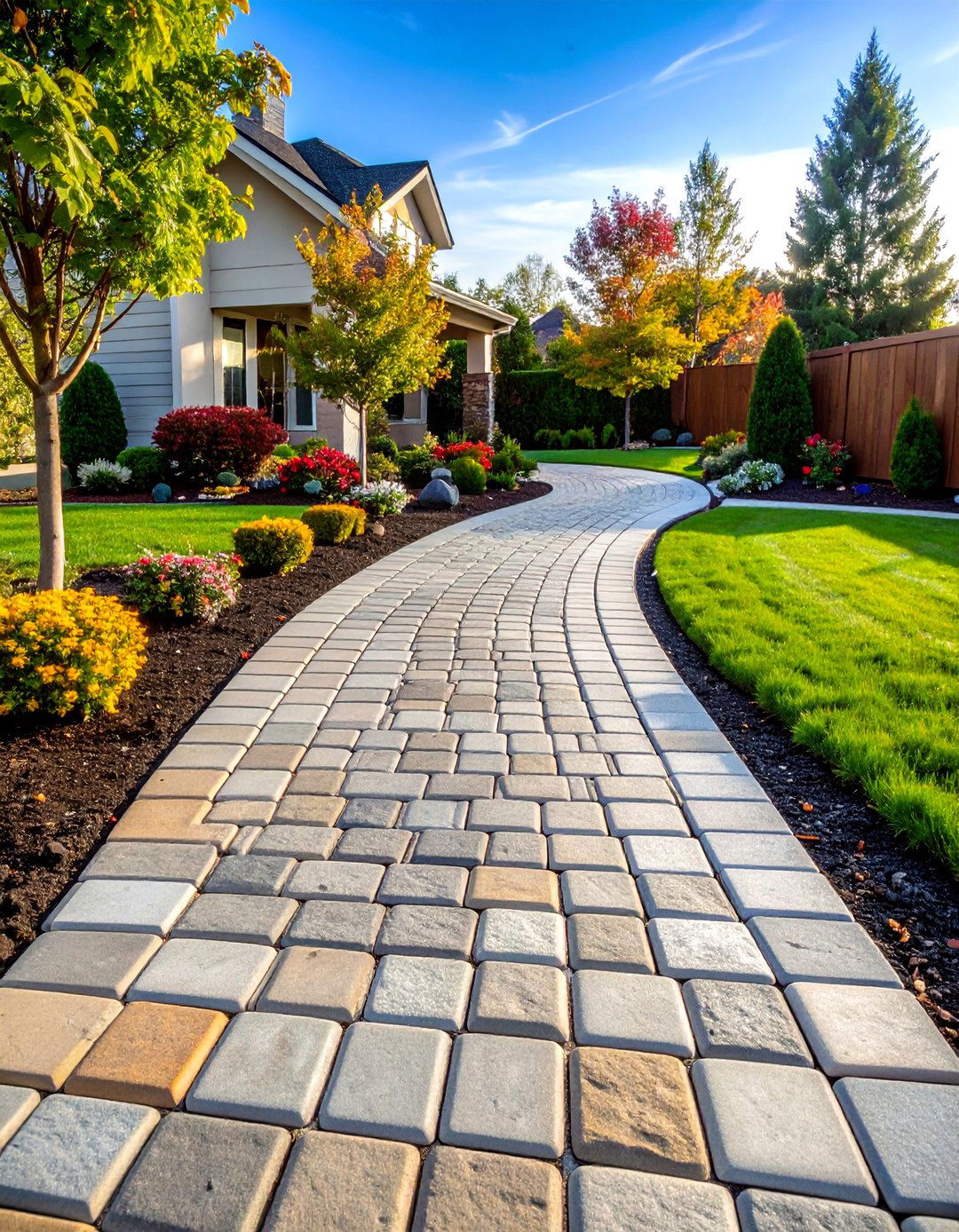

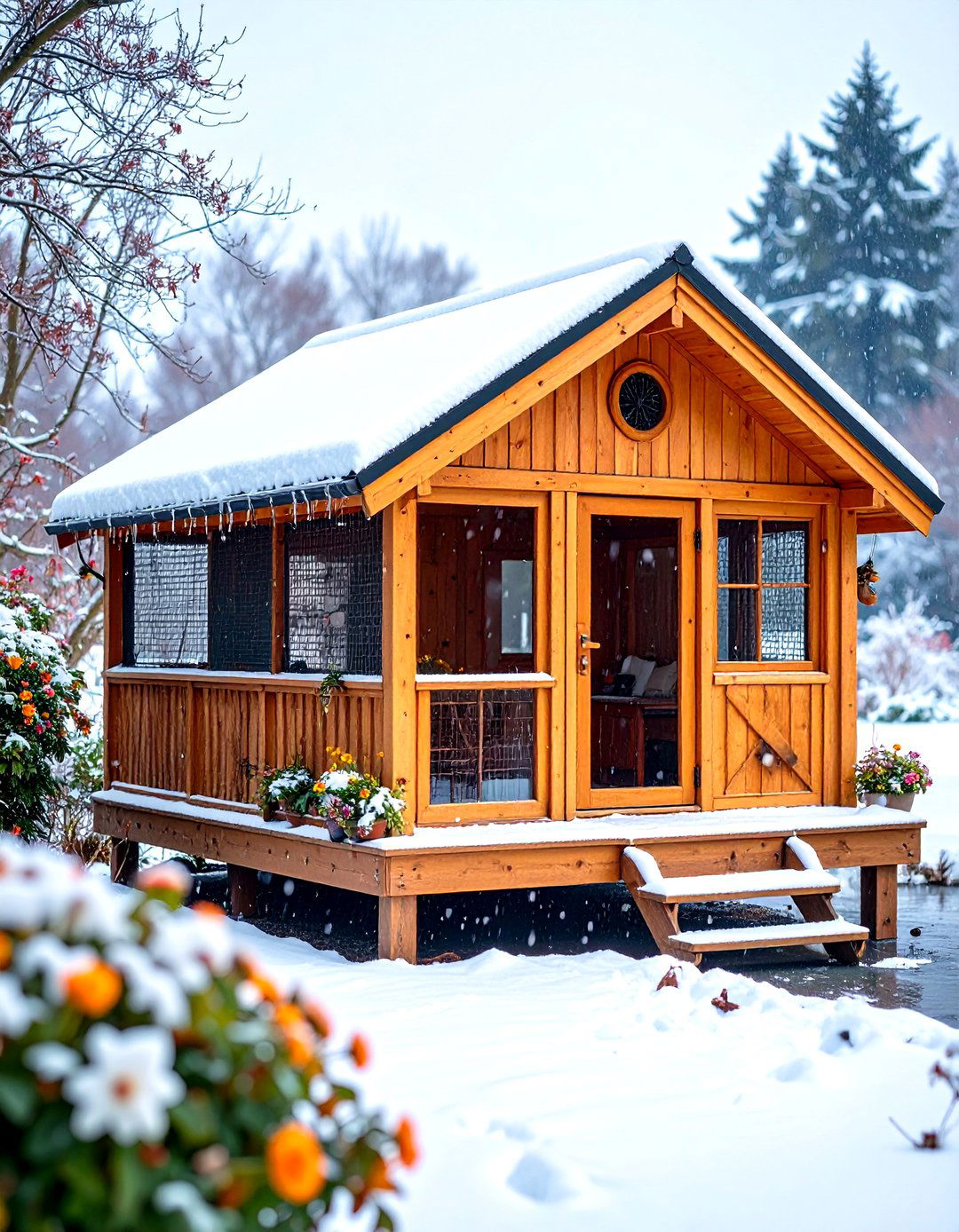
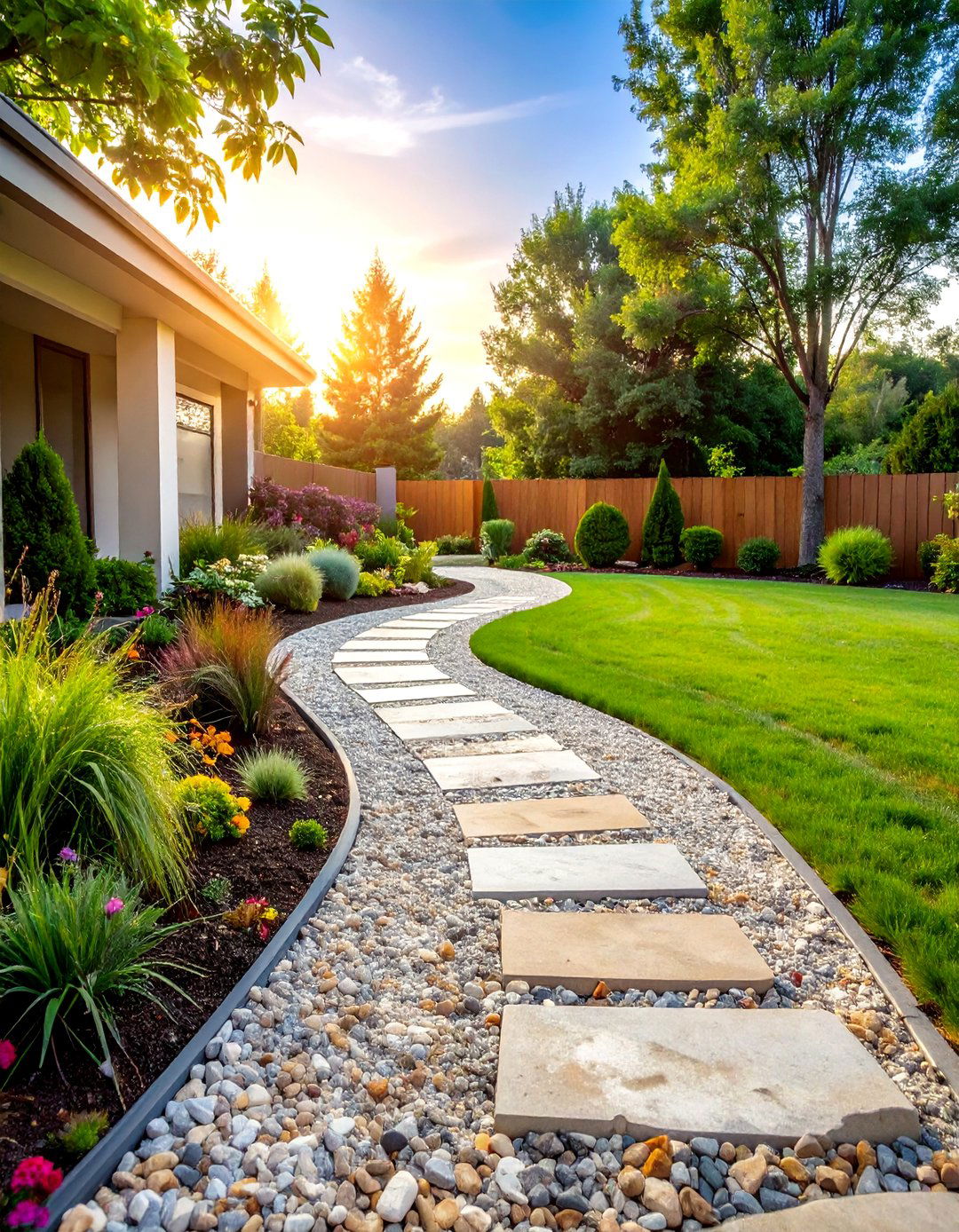

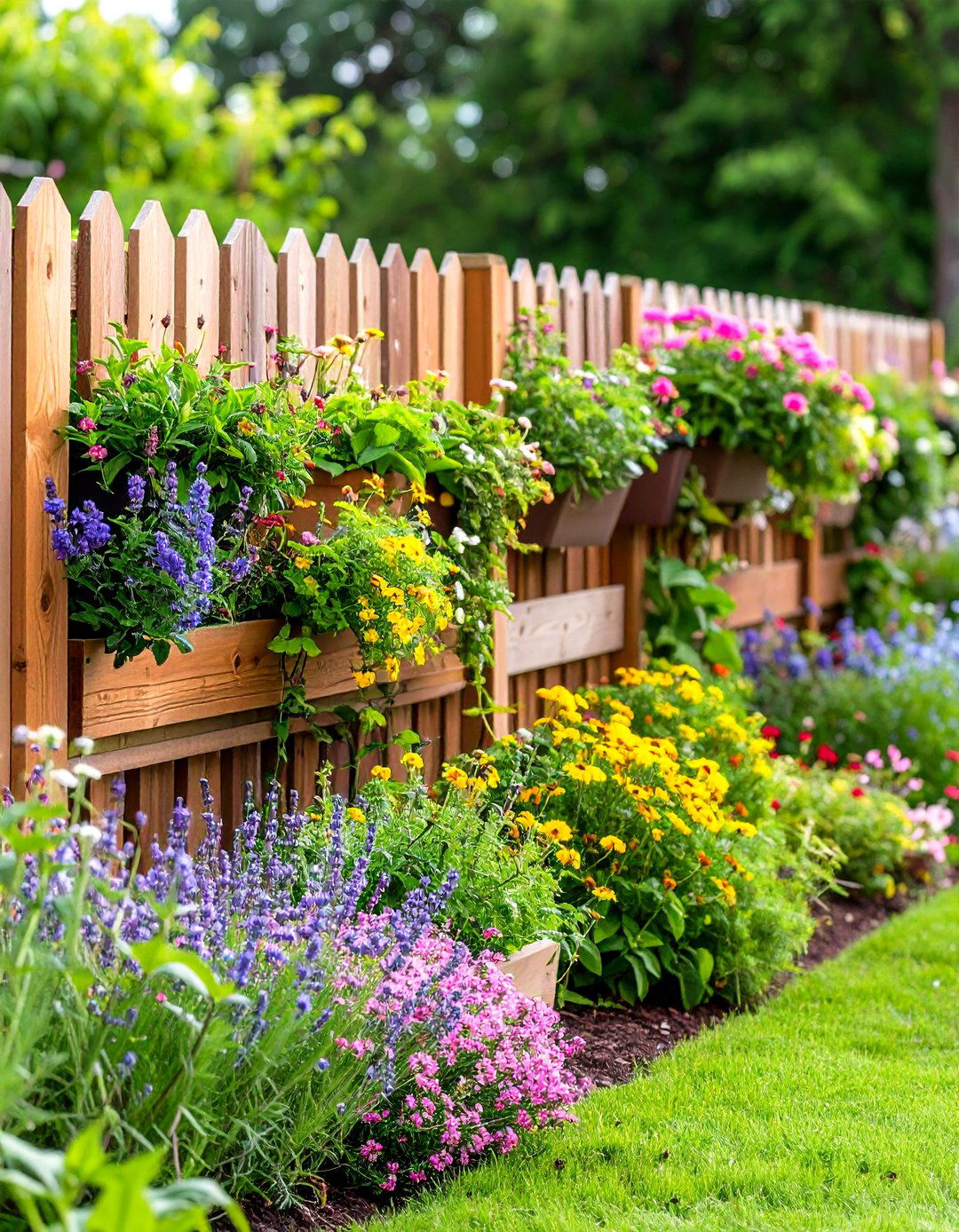
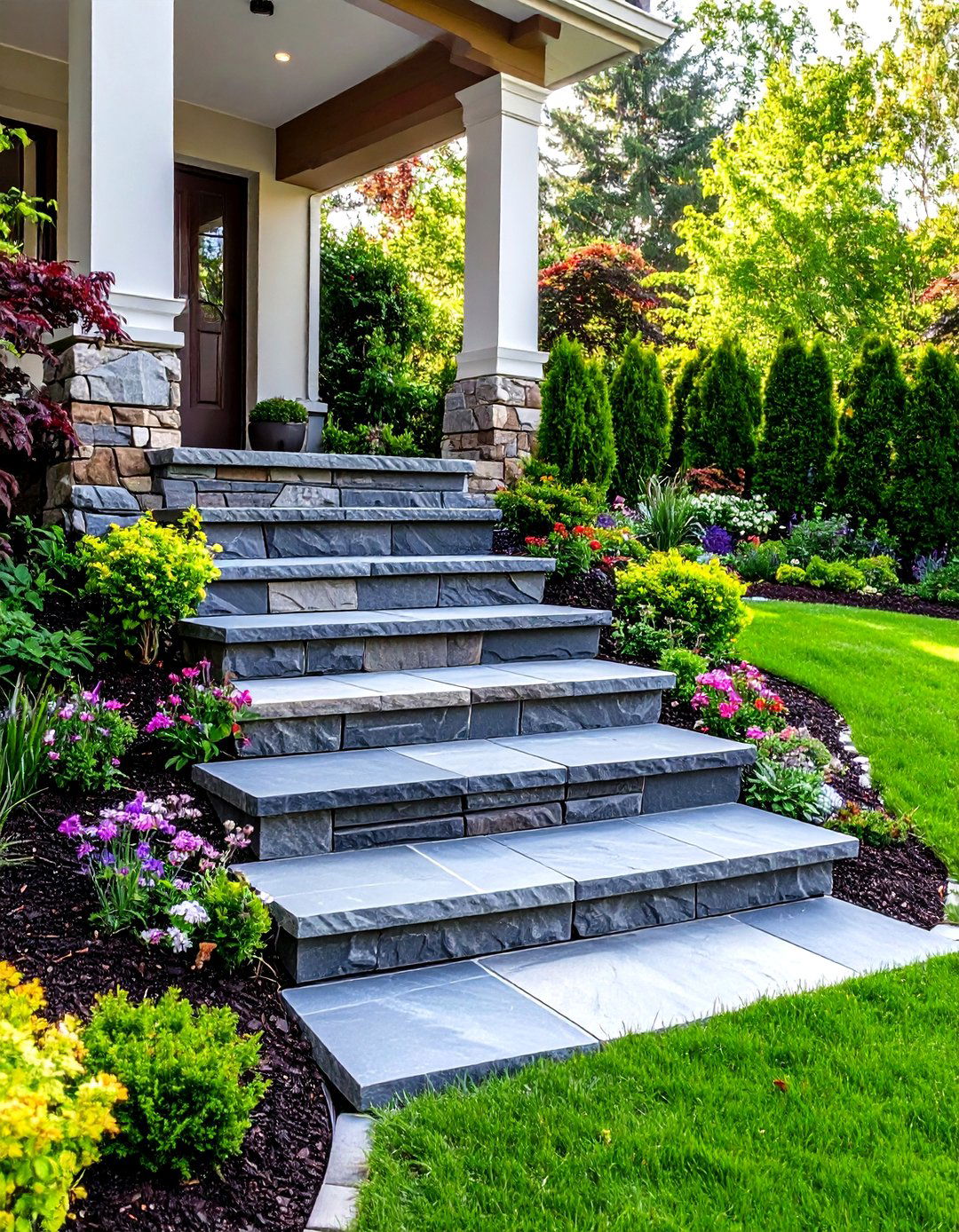


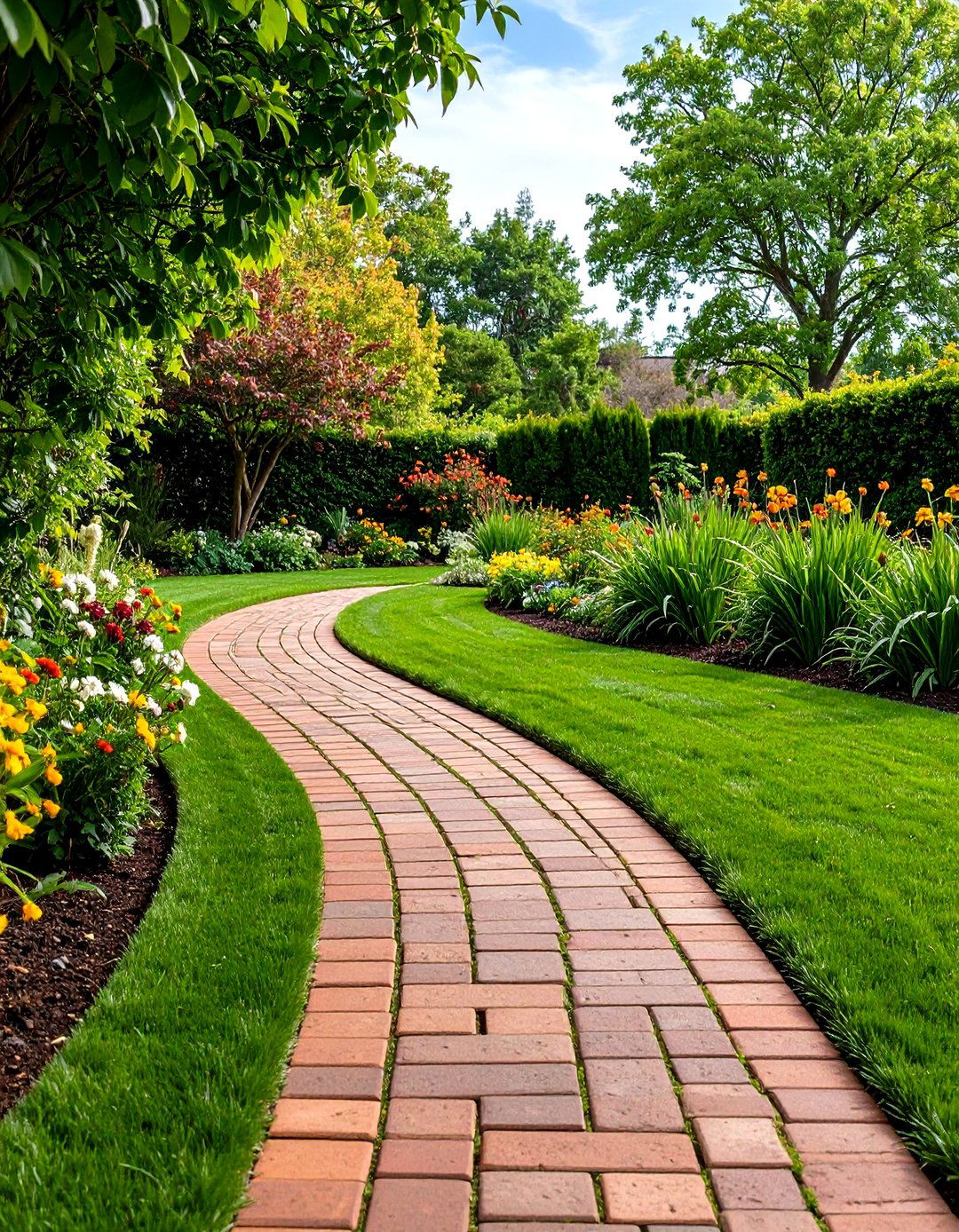
Leave a Reply